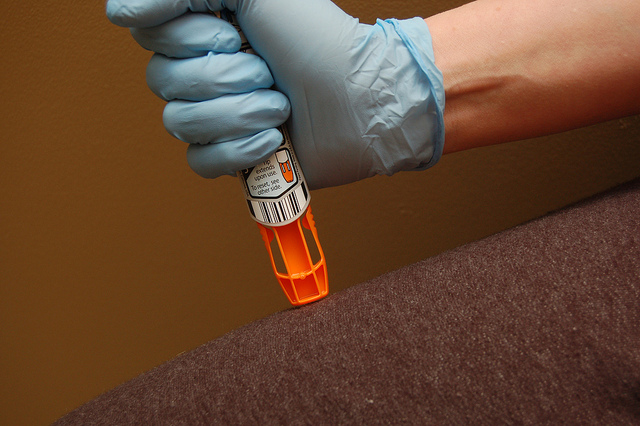Allergies are caused by reactions of the immune system to elements called allergens. The body treats these allergens as foreign objects and activates the immune system to help protect the body against their potential attack. In particular, the immune system produces the IgE antibody when it encounters antigens. After the first exposure to an antigen, the body becomes sensitized to the substance so that every following exposure will result in an allergic response.
Allergic reactions can vary in location, duration, and degree. Anaphylaxis is the most extreme form of an allergic reaction and can cause death. Anaphylaxis is characterized by inflammation, swelling of the lips and mouth, breathing complications, and decreased blood pressure. Often, high-risk individuals carry autoinjectable epinephrine (adrenaline), commonly known as an EpiPen.
EpiPens should only be used in the case of an emergency. They do not cure anaphylaxis or allergies. They simply work to ease symptoms of anaphylaxis. After using an EpiPen, individuals are required to visit a hospital to treat remaining symptoms. The device itself contains a hormone that is normally produced by the human body in the adrenal glands above the kidney, called epinephrine. Epinephrine is related to the body’s “fight or flight” response and allows for vasoconstriction, or shrinking of the veins.
Image Source: Joe Raedle
When experiencing symptoms of anaphylactic shock, individuals should remove the EpiPen from its container and then jab the tip firmly into the upper thigh region, pointing downward, being sure to not twist or bend the EpiPen. Hold the EpiPen in place for at least 10 seconds. The needle allows for the application of epinephrine, which then decreases the size of the blood vessels (vasoconstriction) and increases the space in the airways in the lung, making it easier to breathe. Epinephrine has a very short half-life, meaning that its effects fade quickly. If the symptoms do not subside following a preliminary EpiPen injection, another dose of epinephrine may be required. However, the same EpiPen cannot be used twice. Another fresh EpiPen will need to be injected to provide the second dose of epinephrine.
While EpiPens are not curative solutions for anaphylaxis or allergies, they can provide life-saving care. It is very important to know how to use an EpiPen even if you do not have allergies so that you can help someone self-inject if necessary, in the case of a medical emergency.
Feature Image Source: EpiPen Auto Injector by Greg Friese










